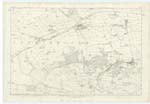OS1/13/27/73
| List of names as written | Various modes of spelling | Authorities for spelling | Situation | Description remarks |
|---|---|---|---|---|
| FORT [Pitlour House] | Fort (Remains of) Fort (Remains of) Fort (Remains of) Fort (Remains of) |
Mr. Skene. Mr Troup. Mr. Skinner. Mr. Howden. [Note] These authorities would prefer having it called a Roman Camp but are willing to let Fort (remains of) appear on the plans. |
016 | [situation] 1 mile N.W. [North West] of Strathmiglo. The remains of an ancient fortress or fort, on the summit of a small hill north of Pitlour House; Commonly called the "Roman Camp". It consists of a ledge of rocks which surrounds almost the summit of the hill. with a very small rampart, partly traceable, the whole of the then existing works had been removed at the time it was planted. Mr. Skene of Pitlour has informed me that he made a minute search to endeavour to discover any remains and found only bones and a small spier head - the latter was sent to the Antiquarian Society, Edinbro' there have been several such weapons found in different parts of the Parish. Colonel Miller has endeavoured to connect this Camp with the Battle of "Mons Grampius" which he has supposed to have been fought in the valley beneath. There is however no authentic proof that it was a Roman Camp, and I have therefore written Fort (Remains of) on the trace, the chain of rocks still bear the name fort. "On the summit of a hill immediately behind Pitlour, and in this Parish, are the remains of an Ancient Fort, called the Roman Camp, which Col. [Colonel]......[continued] |
Continued entries/extra info
73 Plan 16 Abernethy Parish.[Note] "One upper stone of a querne, now preserved in the Museum of the Scottish Antiquaries, was discovered in 1825, along with the remains of an Iron Sword, in digging on the summit of a hill called the Camp, near Pitlour House, Fifeshire. One type in which the upper stone is funnel-shaped with radiating grooves from the centre perforation, is believed to be the portable hand mill of the Roman soldiers. It is engraved as such in Stewart's Caledonia Romana, Plate XIII. [13] The Archaeology and Prehistoric Annals of Scotland. Page 137"
[Note] Viewing this work on the ground, I am of the opinion that it was NOT the work of the Romans. J.B. Capt. [Captain] RE [Royal Engineers]
Transcribers who have contributed to this page.
hastingleigh, MaxInSpain
Location information for this page.
Linked mapsheets.




